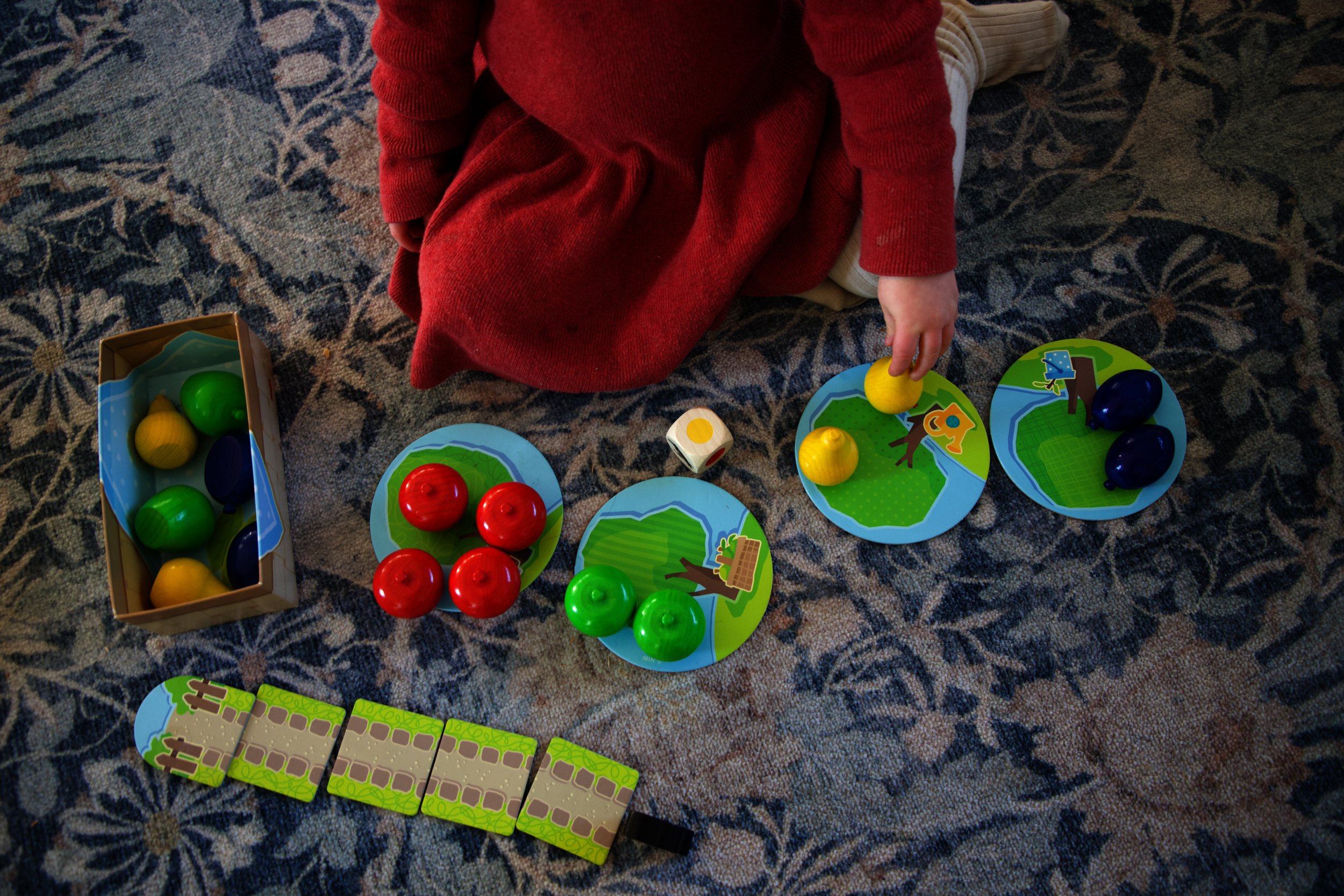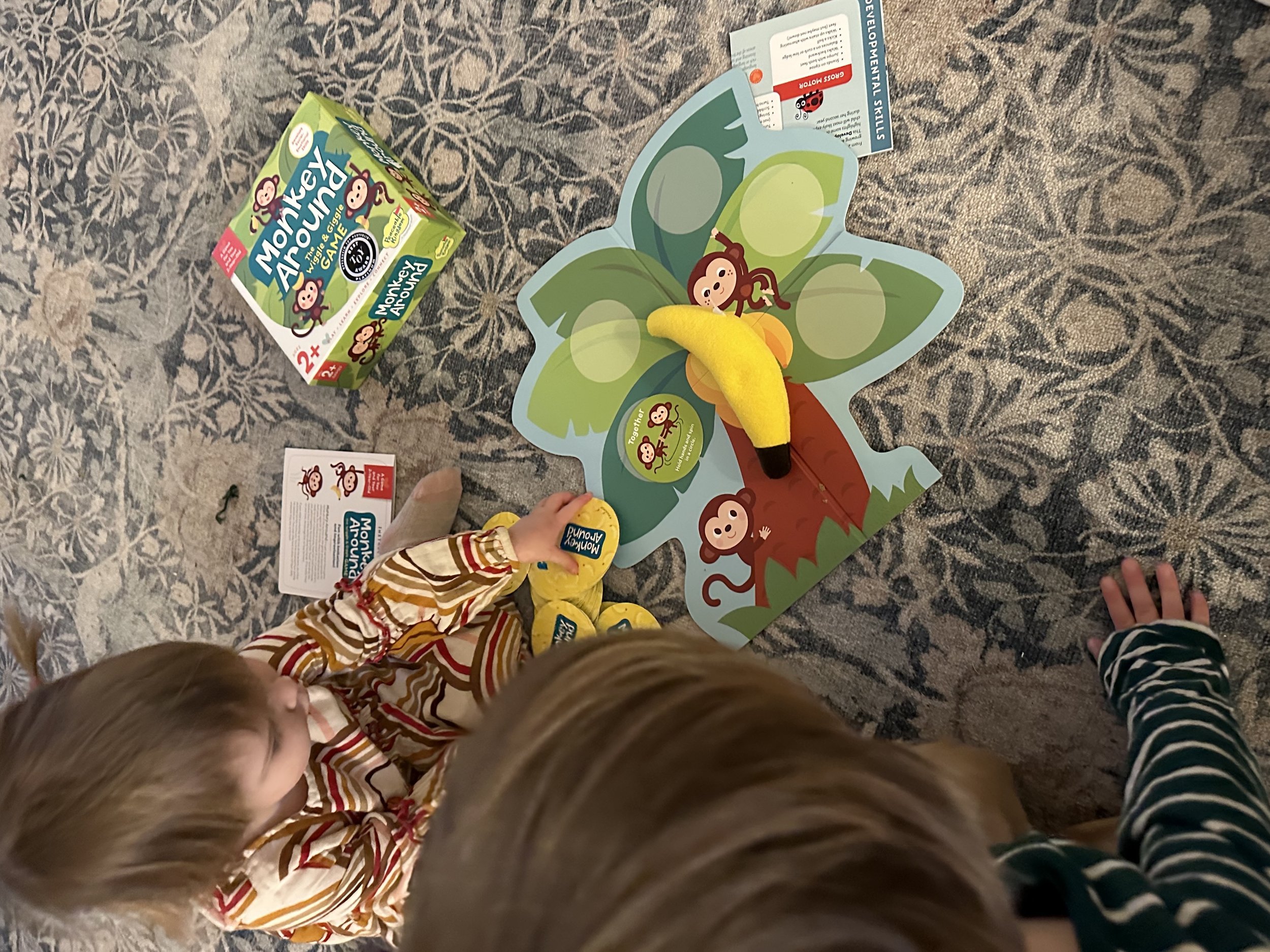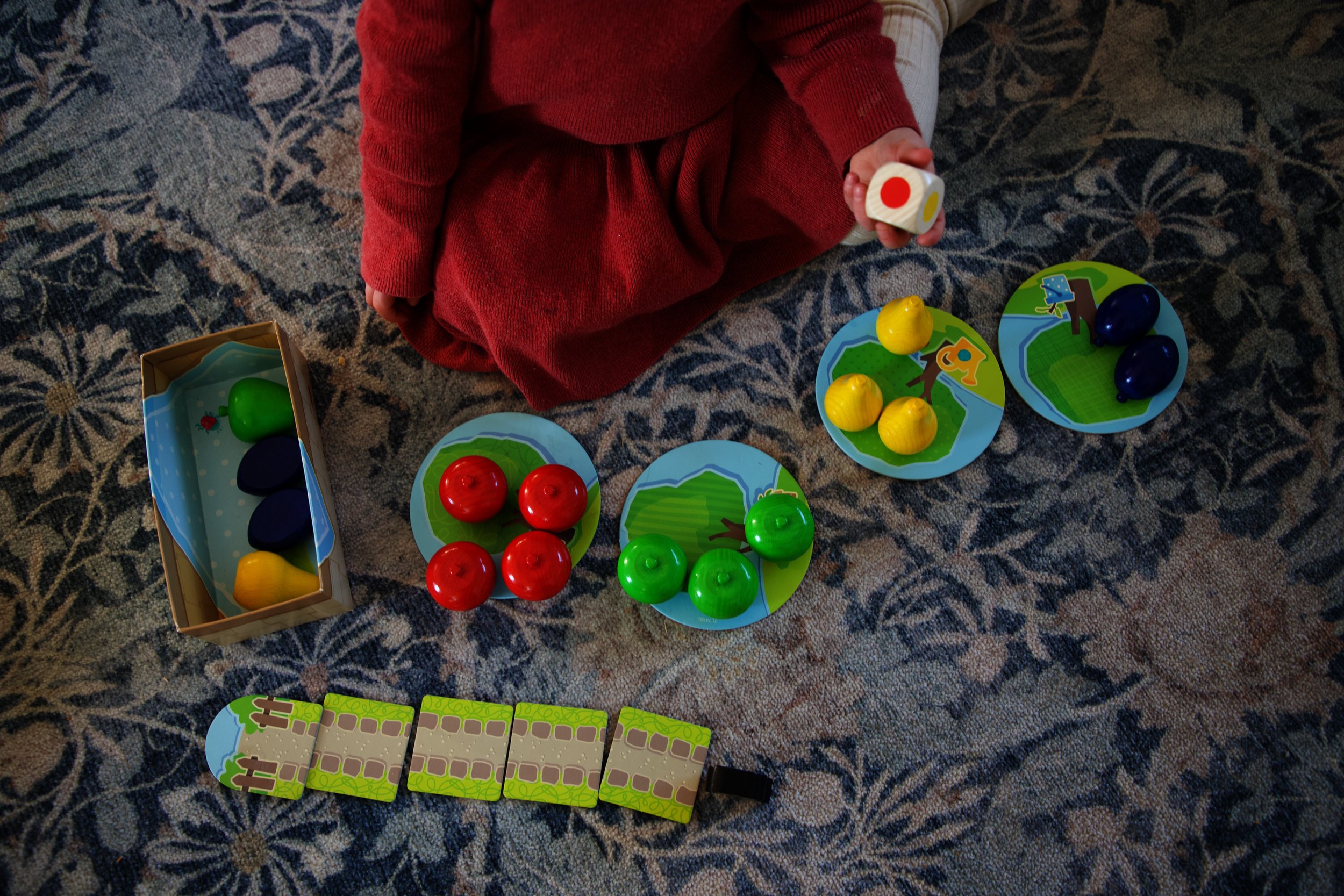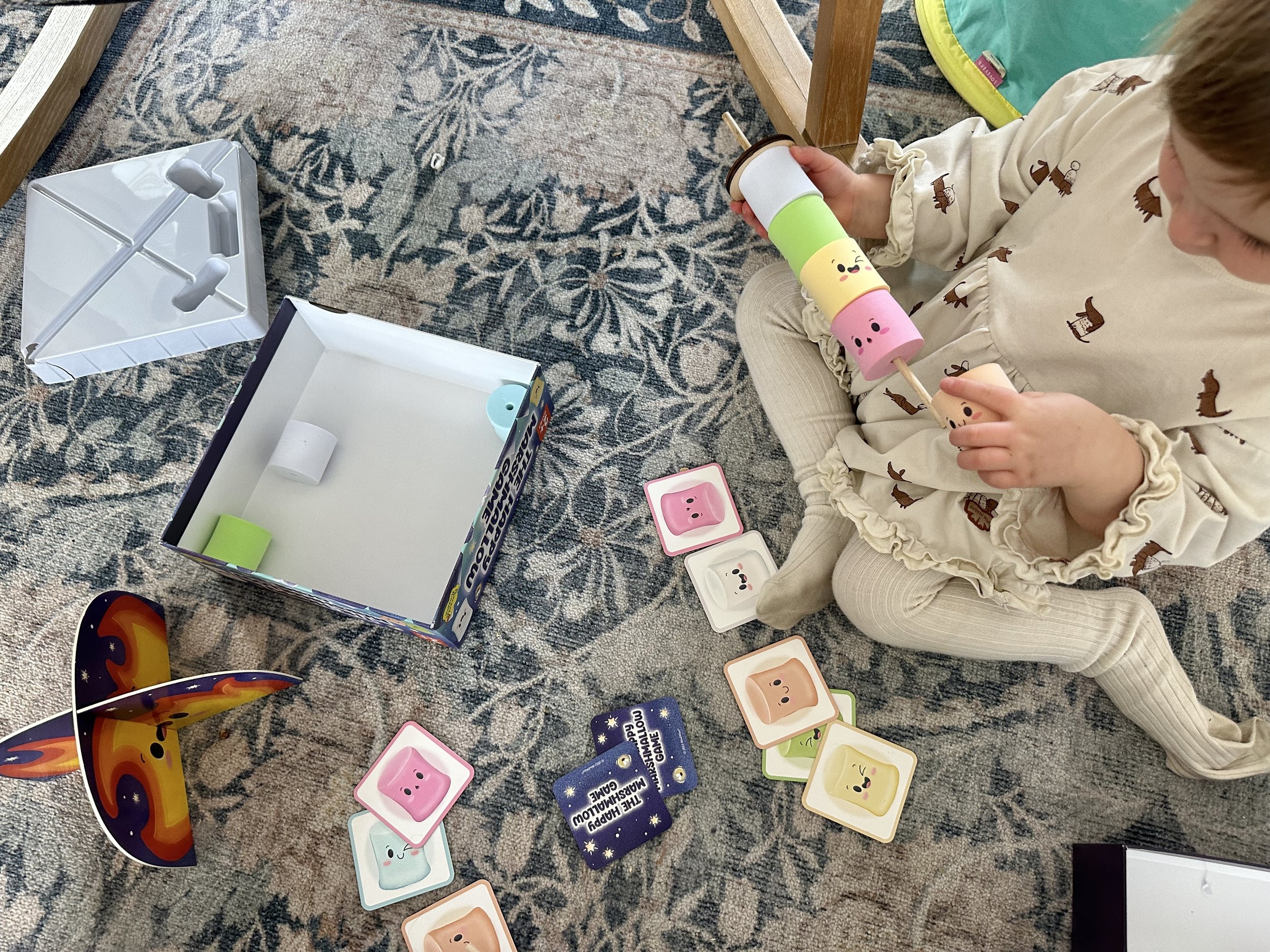Best Board Games for 2-Year-Olds
This post may contain affiliate links, which means I may earn a small commission if you buy through my link but does not change your price.
Can a 2-year-old play a board game? Absolutely! We have had so much fun playing board games with my second two-year-old in our family. When my son was 2 we pretty much only played First Orchard but this time we have explored many more games. Games for 2-year-olds allow for more family play or play with me with both children. I am able to target some skills and language with my 2-year-old while involving my 3-year-old (who always wants to be involved). Though all these games are very easy for him, he still enjoys them. If you’re looking for games more targeted for 3-year-olds, however, check out this post!
A couple of companies make a variety of games for 2-year-olds. Both Peaceable Kingdom and Haba have a whole set of beginner games for 2-year-olds. I review a few of them here but there are more available. Overall, I would say the Haba ones are generally more challenging than the Peaceable Kingdom ones. Though I play some of the Haba ones with my brand new 2-year-old, if you have a brand new 2-year-old new to games Peaceable Kingdom may be a better place to start.
Monkey Around: My son got this for my daughter for Chanukah which fell out right before her 2nd birthday. We started playing right away and both kids loved it. It is silly and all about movement. It is one you could start a bit before 2 but it is still fun for my 3-year-old to play with us. It targets gross motor skills such as jumping, walking backward, and walking on tiptoes. It also practices turn-taking and builds language. I discovered just how good my 2-year-old is at imitating actions! I absolutely recommend this game as a starter game. It is my daughter’s favorite and she calls it “oooh oooh ahh ahh.”
Here Fishy Fishy: My daughter loves this game! It works on color matching, dice rolling, and fine motor skills. You roll the die, take that color fish with the fishing rod, and then put the same color toy in the little puzzle you have. We play mostly by the rules but a little loosely. If you catch a fish that is the wrong color your turn is meant to be over but we try again. We also don’t focus on who wins. My daughter just turned 2 so that makes more sense for us. We do practice turn-taking though and we roll the die and find the same color fish to catch.
First Orchard: This is the main game we had for my son when he was 2 and it is a family favorite for starter games. You roll a die then pick the corresponding fruit off the tree. If you get the raven though the raven moves closer towards stealing your fruit. The goal is to harvest all the fruit before the raven gets to the end of the path. If you get the basket you can choose any color. Some strategy comes into play there as you want to choose from a tree that has more fruit left. A young 2-year-old likely won’t get that but toddlers start to pick up on that over time.
Acorn Soup: This is a cute counting and matching game. The way we play it we match the recipe card with the tokens, working on one-to-one correspondence. We then put it into the soup pot, counting and singing a song. You use a spoon to put the tokens in. That’s a bit challenging but good fine motor work! My daughter also loves to pretend play with it. If we had it when my son was little I think he would have solely played with it by the rules. She loves pretend play though so we generally play a round or two by the rules then she puts all the tokens in to make soup, stirs it up, and serves it. My one complaint is ours came missing some of the berries so we could only make a small number of the recipes. But, I reached out to them on their live chat and they sent more at no charge so it wasn’t a huge deal! This seems to be an issue for others too based on the Amazon reviews. This is particularly something to be mindful of if it is a gift!
Where’s Bear?: This is a favorite for my two to play together. I love that they can play independently and both find so much joy. My son (3.5) will stack the blocks, hiding the bear in one of the levels. My daughter then goes and finds it. There are multiple ways to play and lots of opportunities to target language.
Don’t Break The Ice: This game is technically 3+ (probably due to small parts, though I can’t think of any small parts), but it was easy for my not quite 2-year-old to understand. It is a bit of a pain to set up and at 2 you will definitely be doing all the setting up, but it is an easy and fun way to work on some turn-taking.
The Happy Marshmallow Game: This game works on fine motor skills and color identification. It is also a fun pretend play game. For my son who was not as drawn to pretend play, this would have been fantastic in supporting that (my daughter doesn’t need help in that area)! There is a little song they give for while you toast your marshmallow. Each person takes a turn pulling a marshmallow card, choosing the matching marshmallow, and stringing it on their stick. Once everyone has 4 marshmallows you roast them on the “fire.”
Get Up for Pup: This is another cute movement game. It works on color matching and doing specific movements such as jumping, walking backward, and crawling to feed the puppies. It is a cute and simple game to play with your 2 year old! I like that you scatter the dogs around the room so that you can really get moving!
Friends and Neighbors: I am kind of surprised this Peaceable Kingdom game is listed as 3+ rather than 2+. Perhaps it is because though it is a cooperative game your team can lose and all the Peaceable Kingdom 2-year-old games do not have winning or losing. That said, we got this game from our borrowing library to try with my 3-year-old. The good thing was it was perfect for us to all play together, but it was much too easy for my 3-year-old. It is a very simple matching game and while my not-yet-2-year-old didn’t play it exactly perfectly she was able to do most of it. I have no doubt in a month or so she would have been playing it completely according to the rules. This is a great game for discussing helping others and emotions.
Building Site: I got this game for my first when he was 2. He loved construction but did not love this game. I like a lot of the Haba first games, but this one was simply not a hit for us. It felt more like a reenactment of a story than a game. Our feeling was it was complicated and boring. I know others who like it but, honestly, we donated it to a thrift shop. Again, many others love this though so it might just not have been for us!
Introducing Games to 2-Year-Olds
As I mentioned, I love playing games with both my 2 and 3-year-old (just turned 2 and a few months shy of 4), but one piece of advice I have for introducing these games is to try to find a time to first introduce to your younger child one-on-one. When we first played Acorn Soup, for example, my daughter was just excited to pretend play with it. That is, of course, fine but it was frustrating for my 3-year-old. When I worked one-on-one with her I was able to teach her the rules of the game. This allowed us to play it again later as a group.
That said, some children may just want to play pretend with the pieces and not follow the rules. It is up to you to figure out how the game works best for you. I do try to encourage turn-taking with these games as that is one of my goals for board games together. However, if my little one decides she just wants to pretend play with the pieces I let it go. A few months or even weeks later your child may be more interested in playing by the rules of the game. There is so much development at 2 years old so how your child is one week may be totally different than another week. There also may be novelty in playing with the pieces the first time and more interest in playing more by the rules later.
I also adapt the rules for how it best suits us, as I mentioned in Here Fishy Fishy. I want the games to be fun, work on some of those social-emotional skills, and give us a bonding activity. If the rules feel too complicated or counter to any of that, I adapt.
I introduce the games the same way I do any activity. I present at a time my child seems engaged and ready and then I model how, then let them try. If the game doesn’t work for us I give it another try a bit later!








